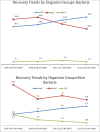Update on the Epidemiology and Antibiotic Resistance of Ocular Infections
- PMID: 28546690
- PMCID: PMC5433126
- DOI: 10.4103/meajo.MEAJO_276_16
Update on the Epidemiology and Antibiotic Resistance of Ocular Infections
Abstract
Purpose: The purpose of this review is to provide an update on the epidemiology and current antibiotic-resistant threats in ophthalmology.
Methods: Trends in frequency and antibiotic-nonsusceptible profiles during an 11 year-period (2005-2015) were evaluated and compared with the 5-year Antibiotic Resistance Monitoring in Ocular Microorganism (ARMOR) study.
Results: Trends in the current review confirmed the continued high rates of fluoroquinolone nonsusceptbility circulating among ocular methicillin-susceptible Staphylococcus aureus, methicillin-susceptible Staphylococcus epidermidis, methicillin-resistant S. aureus, and methicillin-resistant S. epidermidis isolates as well as the detection of uncommon, but emerging resistance (<5%) for Streptococcus pneumoniae, Streptococcus viridans group, Haemophilus influenzae, and Pseudomonas aeruginosa. We documented significant differences in empirical fluoroquinolone and aminoglycoside coverage for the top three ocular pathogens (coagulase-negative staphylococci, S. aureus, and P. aeruginosa) in general and for corneal isolates between the Miami and the ARMOR studies. Collectively, the coverage for Miami was 74% versus 65.9% for ARMOR (P < 0.0001, 5.3674-10.8042) for ciprofloxacin and 95.9% versus 84.2% for aminoglycosides (gentamicin/tobramycin) (P < 0.0001, 9.9925-13.3974). Monotherapy coverage for ciprofloxacin and levofloxacin for the most recent 5 years (2011-2015) was 76.6% and 77.1%, respectively. Combination therapy with a fluoroquinolone and vancomycin and/or vancomycin and an aminoglycoside provided coverage for 99% and 98% of the isolates, respectively.
Conclusion: The etiology of ocular pathogens is patient, source, and geography specific. The true incidence and/or prevalence are unknown. Fluoroquinolone monotherapy as standard therapy for common ocular infections needs to be reassessed. Ophthalmologists must become proactive and join the crusade to develop practical and prudent strategies for the administration of topical antibiotics.
Keywords: Antibiogram; antibiotic resistance; diversity; nonsusceptibility.
Conflict of interest statement
There are no conflicts of interest.
Similar articles
-
Antibiotic Resistance Among Ocular Pathogens in the United States: Five-Year Results From the Antibiotic Resistance Monitoring in Ocular Microorganisms (ARMOR) Surveillance Study.JAMA Ophthalmol. 2015 Dec;133(12):1445-54. doi: 10.1001/jamaophthalmol.2015.3888. JAMA Ophthalmol. 2015. PMID: 26502312
-
Trends in Antibiotic Resistance Among Ocular Microorganisms in the United States From 2009 to 2018.JAMA Ophthalmol. 2020 May 1;138(5):439-450. doi: 10.1001/jamaophthalmol.2020.0155. JAMA Ophthalmol. 2020. PMID: 32271355 Free PMC article.
-
Monitoring antibiotic resistance in ocular microorganisms: results from the Antibiotic Resistance Monitoring in Ocular micRorganisms (ARMOR) 2009 surveillance study.Am J Ophthalmol. 2011 Oct;152(4):567-574.e3. doi: 10.1016/j.ajo.2011.03.010. Epub 2011 Jun 8. Am J Ophthalmol. 2011. PMID: 21652021
-
Microbiological spectrum and antibiotic sensitivity in endophthalmitis: a 25-year review.Ophthalmology. 2014 Aug;121(8):1634-42. doi: 10.1016/j.ophtha.2014.02.001. Epub 2014 Apr 2. Ophthalmology. 2014. PMID: 24702755 Review.
-
Review of resistance of ocular isolates of Pseudomonas aeruginosa and staphylococci from keratitis to ciprofloxacin, gentamicin and cephalosporins.Clin Exp Optom. 2011 Mar;94(2):161-8. doi: 10.1111/j.1444-0938.2010.00536.x. Epub 2010 Nov 17. Clin Exp Optom. 2011. PMID: 21083760 Review.
Cited by
-
Ocular Infection Update.Middle East Afr J Ophthalmol. 2017 Jan-Mar;24(1):1. doi: 10.4103/meajo.MEAJO_103_17. Middle East Afr J Ophthalmol. 2017. PMID: 28546685 Free PMC article. No abstract available.
-
Culture positivity and distribution of the conjunctival sac bacteria in the perioperative period of corneal refractive surgery.Sci Rep. 2024 Aug 7;14(1):18364. doi: 10.1038/s41598-024-69060-9. Sci Rep. 2024. PMID: 39112522 Free PMC article.
-
Evidence of Antibiotic Resistance from Population-Based Studies: A Narrative Review.Infect Drug Resist. 2021 Mar 3;14:849-858. doi: 10.2147/IDR.S289741. eCollection 2021. Infect Drug Resist. 2021. PMID: 33688220 Free PMC article. Review.
-
Co-Existence of Certain ESBLs, MBLs and Plasmid Mediated Quinolone Resistance Genes among MDR E. coli Isolated from Different Clinical Specimens in Egypt.Antibiotics (Basel). 2021 Jul 9;10(7):835. doi: 10.3390/antibiotics10070835. Antibiotics (Basel). 2021. PMID: 34356756 Free PMC article.
-
Baerveldt Scleral Patch Graft Abscess Secondary to Coagulase-Negative Staphylococcus.Case Rep Ophthalmol. 2017 Nov 17;8(3):521-526. doi: 10.1159/000484918. eCollection 2017 Sep-Dec. Case Rep Ophthalmol. 2017. PMID: 29282404 Free PMC article.
References
-
- McDonald M, Blondeau JM. Emerging antibiotic resistance in ocular infections and the role of fluoroquinolones. J Cataract Refract Surg. 2010;36:1588–98. - PubMed
-
- Antibiotic resistance threats in the United States, 2013. Atlanta: CDC; 2013. [Last accessed on 2016 Jul 14]. Centers for Disease Control and Prevention (CDC) Available from: http://www.cdc.gov/drugresistance/threat-report-2013/pdf/arthreats-2013-... .
-
- Kowalski RP. Is antibiotic resistance a problem in the treatment of ophthalmic infections? Expert Rev Ophthalmol. 2013;8:119–26.
MeSH terms
Substances
LinkOut - more resources
Full Text Sources
Medical


